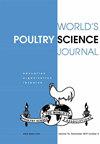蛋鸡饲粮中酵母对生产、健康、蛋成分和经济的影响
IF 3.5
3区 农林科学
Q1 AGRICULTURE, DAIRY & ANIMAL SCIENCE
引用次数: 2
摘要
世界各地的科学家对开发新的技术和材料作为家禽业抗生素的替代品越来越感兴趣。研究人员的努力不仅包括在家禽饲料中替代抗生素生长促进剂,还包括减少家禽工业中兽医抗生素的过度使用,以实现有机产品。已有几种方法被用作抗生素替代品,包括使用有益细菌或草药。最近,在日常补充方案中使用益生菌来源已成为商业家禽生产中的常见常规。几十年来,酵母及其衍生物被认为是动物饲料中最重要的微生物之一。酵母在几个生态过程中很重要,例如能量和碳的耗散以及土壤生态系统中有机物质的矿化,以及与其他微生物的寄生、互惠、共生和竞争相互作用。酵母衍生产品中营养代谢物的组合通过平衡免疫系统来促进鸟类健康,同时提高营养物质的消化率和肠道健康。由于禁止使用抗菌生长促进剂,基于酵母的产品由于其健康和营养优势正在成为家禽饲料的替代补充剂。最近,几项研究表明,在蛋鸡饲料中加入酵母可以提高营养利用率,增加产蛋量和蛋重。本文将讨论酵母在蛋鸡营养中的应用,作为有机家禽生产中替代传统生长刺激剂的一种方法。本文章由计算机程序翻译,如有差异,请以英文原文为准。
Yeast in layer diets: its effect on production, health, egg composition and economics
SUMMARY Scientists throughout the world are increasingly interested in developing novel technologies and materials as alternatives to antibiotics in the poultry industry. The researchers’ efforts include not just substituting antibiotic growth promoters in poultry feeds, but also reducing the total overuse of veterinary antibiotics in the poultry industry in order to achieve organic products. Several approaches have been applied as antibiotic substitutes, including the use of beneficial bacteria or medicinal herbs. Recently, using probiotic sources in a daily supplement regimen has become a common routine in commercial poultry production. For many decades, yeast and its derivatives were regarded as one of the most important microorganisms used in animal feed. Yeasts are important in several ecological processes for instance the dissipation of energy and carbon and mineralisation of organic material through the soil ecosystem as well as are involved in parasitic, mutualistic, symbiotic, and competitive interactions with other microorganisms. The combination of nutritional metabolites in the yeast-derived product induces the birds’ health via balancing the immune system while heightening nutrient digestibility and gut health. Owing to prohibitions on using antimicrobial growth promoters, yeast-based products are becoming alternative supplements in poultry feed due to their health and nutritional advantages. Recently, several studies have shown that the inclusion of yeast in layer chicken feeds enhanced nutrient utilisation and increased egg production and egg weight. This review will discuss the uses of yeast in layer nutrition as an alternative method for organic poultry production to conventional growth stimulators.
求助全文
通过发布文献求助,成功后即可免费获取论文全文。
去求助
来源期刊

World's Poultry Science Journal
农林科学-奶制品与动物科学
CiteScore
6.10
自引率
7.40%
发文量
55
审稿时长
12-24 weeks
期刊介绍:
World''s Poultry Science Journal is the official publication of the World’s Poultry Science Association. The journal provides authoritative reviews in poultry science and an international forum for the exchange and dissemination of information including research, education and industry organisation. Each issue includes poultry industry-related news, regional reports on global developments in poultry, reports from specialist scientific working groups, book reviews, association news and a calendar of forthcoming events. Coverage includes breeding, nutrition, welfare, husbandry, production systems, processing, product development, physiology, egg and meat quality, industry structure, economics and education. The journal is of interest to academics, researchers, students, extension workers and commercial poultry producers.
 求助内容:
求助内容: 应助结果提醒方式:
应助结果提醒方式:


